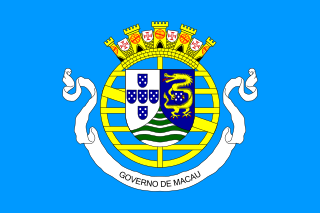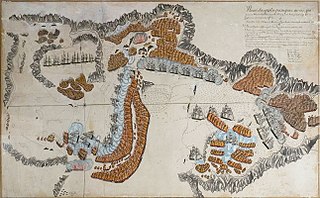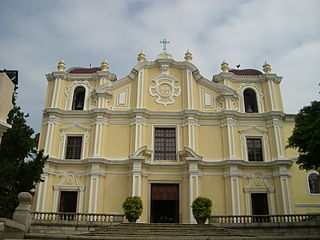 W
WPortuguese Macau covers Macau's history from the establishment of a Portuguese settlement in 1557 to the end of Portuguese colonial rule and transfer of full sovereignty to the People's Republic of China in 1999. Macau was both the first and last European holding in China.
 W
WThe Battle of Macau in 1622 was a conflict of the Dutch–Portuguese War fought in the Portuguese settlement of Macau, in southeastern China. The Portuguese, outnumbered and without adequate fortification, managed to repel the Dutch in a much-celebrated victory on 24 June after a three-day battle. The battle is the only major engagement that was fought between two European powers on the Chinese mainland.
 W
WThe Battle of the Barrier was fought between British and Chinese forces at the boundary separating Macao from the Chinese mainland on 19 August 1840 during the First Opium War. Located in modern-day Portas do Cerco, the Macao Peninsula was connected to Xiangshan Island by a narrow isthmus about 100 m (330 ft) wide and 1.2 km (0.75 mi) long. A wall called the Barrier was built across the isthmus in 1573, and it served as Macao's border.
 W
WThe Battle of the Tiger's Mouth was a series of engagements between a Portuguese flotilla stationed in Macau, and the Red Flag Fleet of the Chinese pirate Ching Shih, led by her second-in-command, the notorious Cheung Po Tsai - known among the Portuguese as Cam Pau Sai or Quan Apon Chay. Between September 1809 and January 1810, the Red Flag Fleet suffered defeat at the hands of the Portuguese fleet led by José Pinto Alcoforado e Sousa, within the Humen Strait - known to the Portuguese as the Boca do Tigre - until finally surrendering formally in February 1810. As her fleet surrendered, Ching Shih herself abandoned piracy on the occasion.
 W
WThe Casa Garden is a small parkette located in Santo António, Macau, China. The area is the headquarters of the Macau delegation of the Orient Foundation.
 W
WThe Dom Pedro V Theatre, is a historical theatre situated at Largo de Santo Agostinho in São Lourenço, Macau, China. It is one of the first western-style theatres in East Asia. The theater is an important landmark in the region and remains a venue for important public events and celebrations today.
 W
WFortaleza do Monte is a fort in Santo António in Macau SAR, China. It is the historical military centre of Macau. The fort forms part of the "Historic Centre of Macau" and is a UNESCO World Heritage Site.
 W
WThe Governor of Macau was a Portuguese colonial official who headed the colony of Macau, before 1623 called Captain-major. The post was replaced on 20 December 1999 upon the transfer of sovereignty over Macau to China by the office of the Chief Executive of Macau.
 W
WThe Guia Fortress is a 17th-century colonial military fort, chapel, and lighthouse complex in São Lázaro, Macau, China. The complex is part of the UNESCO World Heritage Site Historic Centre of Macau.
 W
WThe Cathedral of the Nativity of Our Lady also Sé Catedral da Natividade de Nossa Senhora and Igreja da Sé is a cathedral in Sé, Macau, China. It is the current cathedral of the Diocese of Macau. The cathedral is also called the "Church of the Nativity of Our Lady".
 W
WThe Luso-Chinese agreement of 1554 was a trade agreement between the Portuguese headed by Leonel de Sousa, and the authorities of Guangzhou headed by the Provincial Admiral Wang Bo (汪柏), which allowed for the legalization of Portuguese trade in China by paying taxes. It opened a new era in Sino-Portuguese relations, as Portuguese were until then officially barred from trading in the region. In 1517 an embassy led by Fernão Pires de Andrade to the Ming court failed and, after conflicts in 1521 and 1522, trade was conducted as smuggling and was fought by the authorities, who considered Portuguese to be "Folangji" (Frankish) pirates.
 W
WThe Passaleão incident, also known as the Battle of Passaleão or Baishaling incident, was a conflict between Portugal and China over Macau in August 1849. The Chinese were defeated in the only military confrontation, but the Portuguese called off further punitive measures after a naval explosion killed about 200 sailors.
 W
WThe Portas do Cerco is an area in Nossa Senhora de Fátima, Macau, China. Located on the northern tip of the Macau Peninsula, it is known by the Barrier Gate separating Macau from mainland China. The Portuguese built the gate in 1849 to replace a crumbling wall that the Chinese erected during the Ming dynasty in 1573. The Chinese built a garrisoned wall to control the flow of people and goods. It was the site of the Passaleão incident, a clash between the Qing dynasty and the Kingdom of Portugal in 1849 over the death of Macau's governor Ferreira do Amaral. Led by Colonel Mesquita, Portugal won the small battle which led to the extension of Macau's border northwards. At the limit of said expansion, the Portas do Cerco was built with the inscription "A pátria honrai, que a pátria vos contempla" on the façade on its inner arch in 1849. The Barrier Gate served as a de facto boundary, but the precise limits of Macau's border has never been formally demarcated.
 W
WThe Ruins of Saint Paul's are the ruins of a 17th-century Catholic religious complex in Santo António, Macau, China. They include what was originally St. Paul's College and the Church of St. Paul also known as "Mater Dei", a 17th-century Portuguese church dedicated to Saint Paul the Apostle. Today, the ruins are one of Macau's best known landmarks and one of the Seven Wonders of Portuguese Origin in the World. In 2005, they were officially listed as part of the Historic Centre of Macau, a UNESCO World Heritage Site.
 W
WThe Sino-Portuguese Treaty of Peking was a trade treaty between the Kingdom of Portugal and the Qing dynasty of China, signed on 1 December 1887. It is counted by the Chinese as among the unequal treaties in the aftermath of the Second Opium War. The treaty gave Portugal perpetual colonial rights to Macau on the condition that Portugal would cooperate in efforts to end the smuggling of opium.
 W
WThe St. Joseph's Seminary and Church is a seminary and church located in São Lourenço, Macau, China.
 W
WThe transfer of sovereignty of Macau from Portugal to the People's Republic of China (PRC) occurred on 20 December 1999.
 W
WThe Section of the Old City Walls are the remains of a wall that surrounded the colonial city of Macau, in Portuguese Macau, in the 16th and 17th centuries.